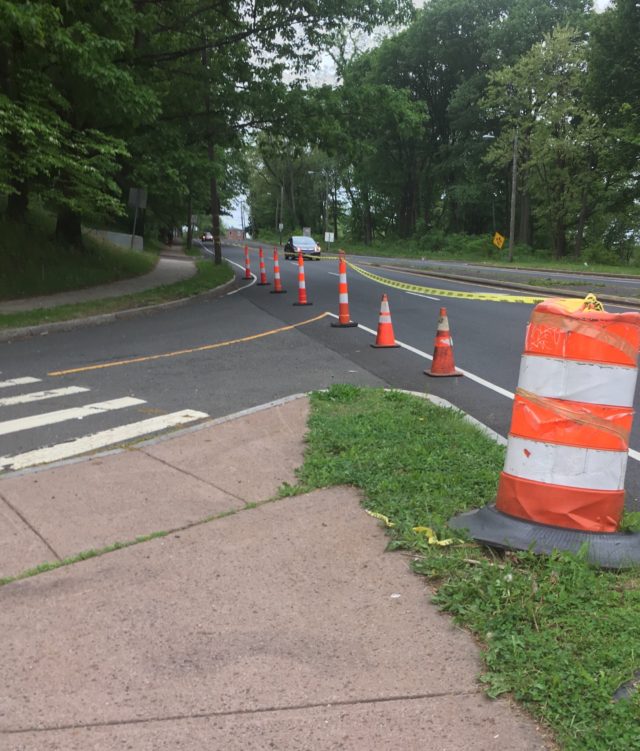
My notebook falls open to pages of scribbles dated November 2014. The notes reflect a presentation about possibilities. A roundabout at the Park Terrace, Russ and Sigourney Street intersection. The installation of a cycletrack on Sigourney Street from that roundabout to Farmington Avenue. A bike box at the intersection of Sigourney and Hawthorne Streets. Three-and-a-half years later, none of those concepts have materialized.
So much depends on the I-84 Project and funding, yes, but also on political will. Or, to put it another way, imagine what Hartford would be like if instead of analysis paralysis as the norm, people conducted a reasonable amount of research, made informed plans, and then implemented them with the willingness to make adaptations as needed.
A version of this appeared in the Frog Hollow neighborhood in May when a redundant lane was temporarily deleted next to the Burns School. Residents used construction cones and caution tape to close a ramp in the neighborhood, one that encourages vehicles to travel too quickly from Park Terrace onto Russ Street in an area used by pedestrians accessing the elementary school, Pope Park North, and other parts of the neighborhood. The end of this lane is marked only by an extremely faded yield sign; predictably, it’s been a crapshoot if motorists taking this ramp yield or even slow down when merging onto Russ Street. Again, these are the roads immediately surrounding an elementary school, near Pope Park North and Bankside Grove, and within a five minute walk of the Sigourney Street CTfastrak station.
Most northbound traffic on Park Terrace turns left onto Sigourney Street to enter I-84 east or continue on through Asylum Hill. Those accessing Russ Street from northbound Park Terrace have had to slow down significantly to make the standard 90 degree right turn. The ramp closure has created no massive traffic jams.
Perfect? No. Better? Undeniably.
Neighborhood residents, including those whose children walk to school, have shown support for the change. Victor Cristofaro, the principal of Burns Latino Studies Academy, has responded positively, and has additional ideas for how the school and community can work together to make safety improvements and simply to collaborate as partners. The crossing guard at Putnam and Russ Streets says that too often, vehicles at this intersection roll on through without stopping.
Frog Hollow is among Hartford’s often overlooked neighborhoods. The sidewalk on Park Street has long been a crumbling mess. When traffic light poles get knocked down, they tend to remain that way; it took the City four months to remove a pole that fell in a storm, and that was with multiple reports made using the Hartford 311 app. If the neighborhood and school community want to begin tackling actual quality of life issues like beautification and pedestrian safety, the City should throw its support behind the momentum.
I am reminded of how years ago I offered to provide the materials and labor to paint the office in which I worked at the time, as the walls were extremely scuffed, making the space uninviting to clients. I was told not to do anything, on account of the union. More than ten years later, the walls remain in sad shape.
It’s worth taking a closer look at the systems we have in place. Are they helpful? Are they functional, or have they drifted away from the spirit in which they were created? Do they provide useful structure or have they become obstacles?
Imagine if we embraced true incremental progress, the kind that steadily improves our environments. Imagine if while waiting for the funding and major projects to be figured out, we took small, relatively inexpensive steps forward and enjoyed those benefits, instead of doing nothing.
Joanna iovino
I work at the school, and I have seen the confess. I was not sure why they were there, and was nervous about walking on the sidewalk and street there for fear it was a structural problem with the street. But I have to say, last week when I came out of work and walked to the bus stop at the corner of park terrace and capital, I felt much safer crossing the ramp, because I did not have to worry about a car traveling too fast not seeing me.